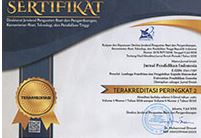Elementary School Students' Mental Health during the Corona Virus Pandemic (COVID-19)
DOI:
https://doi.org/10.23887/jpai.v5i1.34935Keywords:
Students’ mental health, coronavirus pandemic, Strength and Difficulty Questionnaire for Children (SDQ)Abstract
During the Coronavirus (COVID-19) pandemic, changes in routine have affected students’ psychological development. This study aims to determine elementary school students’ mental health during the Corona Pandemic. The benefit of this research is as a basis for efforts to prevent and overcome unexpected psychological conditions in students. This research is a descriptive quantitative study using a survey method. The population in this study were 148 students aged 9-14 years. The data collection technique used was a questionnaire. This study used the Indonesian version of Strength and Difficulty Questionnaire for Children (SDQC) arranged by Robert Goodman. The result showed that the condition of the students was in the "abnormal" category which was indicated by a condition that was less good than the condition in general. There were 17 (11.49%) students in the abnormal category on the disruptive behaviour subscale, 11 (7.43%) students on the hyperactive-inattention subscale, 10 (7%) students on the emotional subscale, 5 (3%) students on the indifference subscale, and 2 (1%) students on the relation problems subscale. Overall aspects of measurement show that the students show a state of "abnormal" status in one or two aspects and it means that students have good mental health.
References
American Psychiatric Association. (2013). Diagnostic and statistical manual of mental disorders (5th Ed.). Arlington, VA: American Psychiatric Association. DOI: https://doi.org/10.1176/appi.books.9780890425596
Arbuckle., & Little. (2004). Teachers’ perceptions and management of disruptive classroom behaviour during the middle years (years five to nine). Australian Journal of Educational & Developmental Psychology, 4, 59-70.
Ariadi, P. (2013). Kesehatan mental dari perspektif Islam. Syifa Medika: Jurnal Kedokteran dan Kesehatan, 3(2), 118-127. http://journal.fkumpalembang.ac.id. DOI: https://doi.org/10.32502/sm.v3i2.1433
Asra, dkk. (2015). Metode penelitian survei. Bogor: In Media Yusuf, M. (2014). Metode penelitian kuantatif, kualitatif, dan penelitian campuran. Jakarta: PT Fajar Interpratama Mandiri.
Bidell, M. P., & Deacon, R. E. (2010). School counselors connecting the dots between disruptive classroom behavior and youth self-concept. Journal of School Counseling, 8(9), 1-30.
Chernyak, N., Harvey, T., Tarullo, A. R., Rockers, P. C., & Blake, P. R. (2018). Varieties of young children’s prosocial behavior in Zambia: The role of cognitive ability, wealth, and inequality beliefs. Frontiers in Psychology, 9, 1–10. https://doi.org/10.3389/fpsyg.2018.02209 DOI: https://doi.org/10.3389/fpsyg.2018.02209
Dalton, L., Rapa, E., & Stein, A. (2020). Protecting the psychological health of children through effective communication about COVID-19. The Lancet Child & Adolescent Health, 4(5): 346-347. https://doi.org/10.1016/S2352-4642(20)30097-3. DOI: https://doi.org/10.1016/S2352-4642(20)30097-3
Danese, A., Smith, P., Chitsabesan, P., Dubicka, B. (2020). Child and adolescent mental health amidst emergencies and disasters. Br J Psychiatry, 216(3), 159-162. DOI:10.1192/bjp.2019.244. DOI: https://doi.org/10.1192/bjp.2019.244
Desiningrum, D. R. (2016). Psikologi siswa berkebutuhan khusus. Yogyakarta: Psikosain.
Dewi, K. S. (2012). Kesehatan mental. Semarang: UPT UNDIP Press.
Dina, L. N. A. B. (2020). Respon orang tua terhadap pembelajaran daring pada masa pandemi Covid-19.
THUFULI: Jurnal Ilmiah Pendidikan Islam Anak Usia Dini, 2(1), 1–12.
Ediati A. (2018). Studi eksploratif problem perilaku pada siswa-siswi sekolah dasar di kota semarang. Prosiding Seminar Nasional Penguatan Peran Keluarga Indonesia di Era Digital untuk Meningkatkan Kualitas Hidup Masyarakat, 29-30 Agustus 2018. Semarang.
Effendi, & Tukiran. (2012). Metode penelitian survei. Jakarta: LP3ES.
Flicker, E. S., & Hoffman, J. A. (2006). Guiding children’s behavior: Developmental discipline in the classroom. New York: Teacher College Press.
Goodman, R. (1997). The strengths and difficulties questionnaire: A research note. Journal of Child Psychology and Psychiatry and Allied Disciplines, 38(5), 581–586. https://doi.org/10.1111/j.1469-7610.1997.tb01545.x DOI: https://doi.org/10.1111/j.1469-7610.1997.tb01545.x
Goodman, R., Ford, T., Simmons, H., Gatward, R., & Meltzer, H. (2003). Using the Strengths and Difficulties Questionnaire (SDQ) to screen for child psychiatric disorders in a community sample. International Review of Psychiatry, 15(1–2), 166–172.
https://doi.org/10.1080/0954026021000046128 DOI: https://doi.org/10.1080/0954026021000046128
Hariz, N., Bawab, S., Atwi, M., Tavitian, L., Zeinoun, P., Khani, M., Maalouf, F. T. (2013). Reliability and validity of the Arabic Screen for Child Anxiety Related Emotional Disorders (SCARED) in a clinical sample. Psychiatry Research, 209(2), 222–228. http://doi.org/10.1016/j.psychres.2012.12.002 DOI: https://doi.org/10.1016/j.psychres.2012.12.002
Hasanah, A. (2017). Pendidikan karakter berperspektif Islam. Bandung: Insan Komunika.
Hasanah, M. (2017). Pengaruh gadget terhadap kesehatan mental siswa. Indonesian Journal of Islamic Early Childhood Education. 2(2). 207-214.
Hawes, D. J., & Dadds, M. R. (2004). Australian data and psychometric properties of the Strengths and Difficulties Questionnaire. Australian and New Zealand Journal of Psychiatry, 38(8), 644– 651. http://doi.org/10.1111/j.1440-1614.2004.01427.x DOI: https://doi.org/10.1080/j.1440-1614.2004.01427.x
Istiqomah. (2017). Parameter psikometri alat ukur Strengths and Difficulties Questionnaire (SDQ). Psympathic: Jurnal Ilmiah Psikologi, 4(2), 251–264. https://doi.org/10.15575/psy.v4i2.1756 DOI: https://doi.org/10.15575/psy.v4i2.1756
Keliat, B. A., Triana, R., & Sulistiowati, N. M. D. (2019). The relationship between self-esteem, family relationships and social support as the protective factors and adolescent mental heatlh. Humanities and Social Sciences Reviews, 7(1), 41–47. https://doi.org/10.18510/hssr.2019.715 DOI: https://doi.org/10.18510/hssr.2019.715
Kumara, A., Wimbarti, S., Susetyo, Y. F., & Kisriyani, A. (2017). The epidemiology of Indonesian children and adolescent school-based mental heatlh: Validation of school-based mental health information system. Universal Journal of Psychology, 5(3), 114-121. doi: 10.13189/ujp.2017.050303. DOI: https://doi.org/10.13189/ujp.2017.050303
Kurniawan, S. (2013). Pendidikan karakter. Yogyakarta: AR-Ruzz Media.
Kurniawan, Y., & Sulistyarini, I. (2016). Komunitas SEHATI (Sehat Jiwa dan Hati) sebagai intervensi kesehatan mental berbasis masyarakat. Jurnal Psikologi dan Kesehatan Mental, 1 (2), 112-124. doi: 10.20473/JPKM.v1i22016.112-124. DOI: https://doi.org/10.20473/jpkm.V1I22016.112-124
Liu, S. K., Chien, Y. L., Shang, C. Y., Lin, C. H., Liu, Y. C., & Gau, S. S. F. (2013). Psychometric properties of the Chinese version of Strength and Difficulties Questionnaire. Comprehensive Psychiatry, 54(6), 720–730. http://doi.org/10.1016/j.comppsych.2013.01.002 DOI: https://doi.org/10.1016/j.comppsych.2013.01.002
Martono, N. (2014). Metode penelitian kuantitatif: Analisis isi dan analisis data sekunder. Jakarta: PT Raja Grafindo Persada.
Mellor, D., Cheng, W., McCabe, M., Ling, M., Liu, Y., Zhao, Z., Xu, Y. (2016). The use of the SDQ with Chinese adolescents in the clinical context. Psychiatry Research, 246, 520– 526. http://doi.org/10.1016/j.psychres.2016.10.034 DOI: https://doi.org/10.1016/j.psychres.2016.10.034
Mieloo, C., Raat, H., van Oort, F., Bevaart, F., Vogel, I., Donker, M., & Jansen, W. (2012). Validity and reliability of the Strengths and Difficulties Questionnaire in 5-6 year olds: Differences by gender or by parental education? PLoS ONE, 7(5). http://doi.org/10.1371/journal.pone.0036805 DOI: https://doi.org/10.1371/journal.pone.0036805
Muhamadi, S. I. (2015). Pembinaan Kejujuran siswa melalui pembelajaran Kitab Bahr Al- Adab. Jurnal Pendidikan Agama Islam, 12(2), 141-160. DOI: https://doi.org/10.14421/jpai.2015.122-02
Muhamadi, S. I., & Hasanah, A. (2019). Penguatan pendidikan karakter peduli sesama melalui kegiatan ekstrakurikuler relawan. Jurnal Pendidikan Agama Islam, 16(1). DOI: https://doi.org/10.14421/jpai.2019.161-06
Nugroho, E. (2018). Prinsip-prinsip menyusun kuesioner. Malang: UB Press.
Nurmalitasari, F. (2015). Perkembangan sosial emosi pada siswa usia prasekolah. Buletin Psikologi, 23(2), 103-111. DOI: https://doi.org/10.22146/bpsi.10567
Oktaviana, M., & Wimbarti, S. (2014). Validasi klinik Strengths and Difficulties Questionnaire (SDQ) sebagai instrumen skrining gangguan tingkah laku. Jurnal Psikologi, 41(1), 101–114. DOI: https://doi.org/10.22146/jpsi.6961
Ortuño-Sierra, J., Aritio-Solana, R., & Fonseca-Pedrero, E. (2018). Mental health difficulties in children and adolescents: The study of the SDQ in the Spanish National Health Survey 2011– 2012. Psychiatry Research, 259, 236–242. http://doi.org/10.1016/j.psychres.2017.10.025 DOI: https://doi.org/10.1016/j.psychres.2017.10.025
Paternotte, A., & Buitelaar, J. (2010). ADHD (Attention Deficit Hyperactivity Dirsoder): Gangguan Pemusatan Perhatian dan hiperaktivitas. Jakarta: Prenada Media Group.
Petermann, U., Petermann, F., & Schreyer, I. (2010). The German Strengths and Difficulties Questionnaire (SDQ) validity of the teacher version for preschoolers. European Journal of Psychological Assessment, 26, 256–262. http://doi.org/10.1027/1015-5759/a000034 DOI: https://doi.org/10.1027/1015-5759/a000034
Pierangelo, R., & Giulani, G. (2015). A step by step guide for educators: Classroom management techniques for students with ADHD. New York: Fisrt Skyhorse Publishing.
Prawitasari, J. E. (2011). Psikologi klinis pengantar terapan mikro dan makro. Jakarta: Erlangga.
Saputra, F. (2017). Mental health problems in Indonesian children: A review study. Annals of Psychiatry and Mental Health, 5(4): 1105.
Sarwono, J. (2011). Mixed methods. Jakarta: PT Elex Media Komputindo.
Siregar, J., & Wimbarti, S. (2018). Screening for the hyperkinetic disorder by using Strength and Difficulties Questionnaire Teacher-Report (SDQ-TR) in Indonesia school-aged children. Global Journal of Psychology Research: New Trends and Issues, 8(2), 76–87. DOI: https://doi.org/10.18844/gjpr.v8i2.3490
Sirgy, M. J. (2021). The psychology of quality of life: Wellbeing and positive mental health (Third edit, Vol. 83). Springer Nature Switzerland AG. DOI: https://doi.org/10.1007/978-3-030-71888-6_4
Smedje, H., Broman, J. E., Hetta, J., & von Knorring, A. L. (1999). Psychometric properties of a Swedish version of the “Strengths and Difficulties Questionnaire”. European Child & Adolescent Psychiatry, 8(2), 63–70.
http://doi.org/10.1007/s007870050086 DOI: https://doi.org/10.1007/s007870050086
Sudaryono. (2016). Metode penelitian pendidikan. Jakarta: Prenada Media Group
Sugiyono. (2012). Metode penelitian kuantitatif, kualitatif dan kombinasi (mixed methods). Bandung: CV Alfabeta.
Sukardi. (2019). Metodologi penelitian pendidikan. Jakarta: Bumi Aksara.
Sukatin, dkk. (2020). Analisis perkembangan emosi siswa usia dini. Jurnal Ilmiah Tumbuh Kembang Siswa Usia Dini, 5(2), 77-90. Doi: https://doi.org/10.14421/jga.2020.52-05 DOI: https://doi.org/10.14421/jga.2020.52-05
Tanabe, T., Kashiwagi, M., Shimakawa, S., Fukui, M., Kadobayashi, K., Azumakawa, K., ... Wakamiya, E. (2013). Behavioral assessment of Japanese children with epilepsy using SDQ (Strengths and Difficulties Questionnaire). Brain & Development, 35(1), 81–86. http://doi.org/10.1016/j.braindev.2012.03.008 DOI: https://doi.org/10.1016/j.braindev.2012.03.008
Taylor, S. (2019). The psychology of pandemics: Preparing for the next global outbreak of infectious disease. Newcastle: Cambridge Scholars Publishing.
UNICEF. (2020, March 18). How to talk to your child about coronavirus disease 2019 (COVID-19). Retrieved from https://www.unicef.org/romania/stories/how-talk-your-child-about-coronavirus-disease-2019-covid-19
Wiguna, T., & Hestyanti Y. (2012). SDQ: Information for researchers and professionals about the Strengths and Difficulties Questionnaire. Indonesian translation. London, United Kingdom: Youth in Mind. Retrieved from http://www.sdqinfo.org
WHO. (2020). Coming of age: Adolescence health. Retrieved from https://www.who.int/news-room/spotlight/coming-of-age-adolescent-health
Yusuf, M. (2014). Metode penelitian kuantatif, kualitatif, dan penelitian campuran. Jakarta: PT Fajar Interpratama Mandiri.










